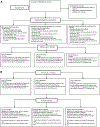Short-Term Impact of "Amaka Amasanyufu" Multiple Family Group Intervention on Mental Health Functioning of Children With Disruptive Behavior Disorders in Uganda
- PMID: 36898607
- PMCID: PMC10330280
- DOI: 10.1016/j.jaac.2022.12.028
Short-Term Impact of "Amaka Amasanyufu" Multiple Family Group Intervention on Mental Health Functioning of Children With Disruptive Behavior Disorders in Uganda
Abstract
Objective: We evaluate the mid-intervention (8 weeks) and short-term (16 weeks) impact of a culturally adapted multiple family group (MFG) intervention, "Amaka Amasanyufu," on the mental health of children with disruptive behavior disorders (DBDs) and primary caregivers in Uganda.
Method: We analyzed data from the Strengthening mental health and research training in Sub-Saharan Africa (SMART) Africa-Uganda study. Schools were randomized to the following: a control group; an MFG facilitated by parent peers (MFG-PP); or an MFG facilitated by community health workers (MFG:CHW). All participants were blinded to interventions provided to other participants and study hypotheses. At 8 weeks and 16 weeks, we evaluated differences in depressive symptoms and self-concept among children and in mental health and caregiving-related stress among caregivers. Three-level linear mixed-effects models were fitted. Pairwise comparisons of post-baseline group means were performed using the Sidak adjustment for multiple comparisons and standardized mean differences. Data from 636 children with DBDs and caregivers (controls: n = 243, n = 10 schools; MFG-PP: n = 194, n = 8 schools; MFG-CHW: n = 199, n = 8 schools) were analyzed.
Results: There were significant group-by-time interactions for all outcomes, and differences were observed mid-intervention, with short-term effects at 16 weeks (end-intervention). MFG-PP and MFG-CHW children had significantly lower depressive symptoms and higher self-concept, whereas caregivers had significantly lower caregiving-related stress and fewer mental health problems, than controls. There was no difference between intervention groups.
Conclusion: Amaka Amasanyufu MFG intervention is effective for reducing depressive symptoms and improving self-concept among children with DBDs while reducing parental stress and mental health problems among caregivers. Given the paucity of culturally adapted mental health interventions, this provides support for adaptation and scale-up in Uganda and other low-resource settings.
Clinical trial registration information: SMART Africa (Strengthening Mental Health Research and Training); https://clinicaltrials.gov/: NCT03081195.
Keywords: caregivers; children; disruptive behavior disorders; mental health; sub-Saharan Africa.
Copyright © 2023. Published by Elsevier Inc.
Figures


References
-
- World Health Organization, Investing in mental health. 2003. Accessed September 6, 2022. https://www.who.int/mental_health/media/investing_mnh.pdf.
Publication types
MeSH terms
Substances
Associated data
Grants and funding
LinkOut - more resources
Full Text Sources
Medical
Miscellaneous

